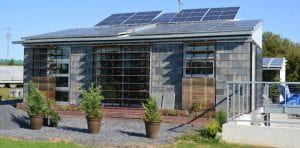Focus
Research on solar energy technologies for building integration and storage; Education and training of tomorrow’s solar workforce.
Highlights
- Visibility. University Park is constructing a utility-scale photovoltaic array for power production and hands-on student training.
- Photovoltaic materials research. Penn State has strength in thin film photovoltaic materials.
- Educational programs. Penn State has solar-related course offerings in multiple departments and online via World Campus.
- Strong industry ties. Penn State has connections with many of the leading solar panel manufacturers and installers across the globe.
Goals
- Build strength in building-integrated photovoltaics and solar energy storage research, with a focus on materials that leverages the opportunities through the MRI.
- Establish a nexus between solar energy, battery, and fuel cell research at Penn State.
- Make Penn State a national destination for residential and online solar education and training.
- Provide the foundation needed to compete for center-level funding opportunities in the future.
Overview

Solar energy has passed a tipping point. The installed solar panel capacity worldwide is doubling every two to three years – faster than the early stages of cell phone adoption. In the United States, the cost of solar power has now reached grid parity (i.e. at or below that of fossil fuels) in twenty states and is projected to fall by another factor of two within the next decade. Solar panel installers are correspondingly projected to be the fastest growing occupation during the same time period.
The growing contribution of solar power to the global energy mix over the next two decades is thus coming into focus and will involve large arrays of solar panels installed in fields and on rooftops. This development is already becoming evident at Penn State, with the MorningStar Solar Home on campus, the solar panel array outside the Office of Physical Plant, and the 2 MW utility-scale photovoltaic array currently being constructed next to Beaver Stadium.
Beyond the horizon of 2030, however, new photovoltaic and storage technologies will be required to sustain the growth of solar energy and enable it to truly become a major player in the world energy mix.

This means moving beyond the ‘one size fits all’ solar panel of today (where the same product is used for urban rooftops and utility-scale solar farms) to solutions that are integrated in the fabric of our infrastructure and transportation. It means being able to store this energy in advanced batteries or in the form of fuels such as hydrogen. From building-integrated photovoltaics needed for ‘net-zero’ energy buildings to flexible high efficiency cells that recharge and extend the range of electric vehicles, the future of solar energy research lies in integration and storage.
Education is a more immediate need to supply the growing solar workforce over the next decade. Currently, no university in the US is recognized as the destination for students, industry- and government-sponsored trainees who want to be a part of the solar industry. Penn State has some of the building blocks to do this, including several residential courses and a graduate certificate in solar energy through the Renewable Energy and Sustainable Systems (RESS) program. However, these offerings are currently too small and too sparse for Penn State to be a major supplier of graduates for the solar workforce.
Strategic Planning
The solar research community at Penn State has a nascent strength in the area of thin film photovoltaic materials and is surrounded by complimentary strengths in battery, hydrogen, and energy-efficient buildings research. However, the community is vulnerable to recent impacts caused by departures of multiple faculty with solar expertise. Thus, there is an acute need for new researchers who can fill these gaps and build the connections between material science, engineering, and architecture that will enable PSU to compete in the translational photovoltaics and storage research areas of the future. To meet this need, we recommend the following actions:
- Hire a senior solar-related faculty member in Chemistry with expertise in solar fuels.
- Create 3 tenure-track faculty lines in a cluster hire targeting a specific opportunity area for PSU such as, e.g. solar fuels or building-integrated solar technologies.
- Support a year-long seminar series under the banner of Energy 2100 to help identify these individuals and determine the hiring focus.
- Provide internal seed funding through IEE for research at the intersection of photovoltaics and electrochemistry to catalyze new collaborations between existing faculty members on solar energy storage.
- Hire 3 teaching faculty to expand residential and online course offerings in solar project planning, finance, manufacturing, hardware, and policy development, with the goal of making PSU a top supplier of graduates that enter the growing solar industry.
List of Participants
- Primary contact
- Prof. Chris Giebink
- Participants
- John Asbury
- Enrique Gomez
- Jeffrey Brownson
- David Riley
Education
- Courses
- EGEE 437
- EME 810
- EME 812
- EME 811
- AE 868
- AE 878
- World campus
- RESS program Graduate Certificate in Solar Energy
- Outreach activities
- MorningStar Solar Home tours for the public
- Engineers Without Borders student trips to install photovoltaic systems
